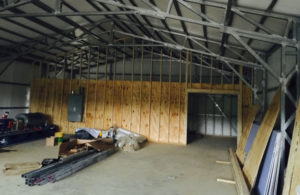
Insulating a metal building is crucial for maintaining comfortable temperatures, preventing condensation, and reducing energy costs. Metal buildings are known for their durability and strength, but they can also be prone to heat loss and gain without proper insulation.
Assess Your Insulation Needs
Begin by assessing your insulation requirements based on factors such as climate, building use, and local building codes. Consider the R-value, which measures the insulation’s thermal resistance. Higher R-values provide better insulation against temperature fluctuations. Additionally, take into account vapor barriers to prevent condensation issues.
Choose the Right Insulation Material
Selecting the appropriate insulation material is crucial. There are several options available for insulating metal buildings, including fiberglass batts, rigid foam boards, spray foam insulation, and reflective insulation. Each material has its own advantages and suitability based on factors like cost, insulation performance, ease of installation, and moisture resistance.
Install Insulation in the Walls
Start by installing insulation in the walls of the metal building. If using fiberglass batts, measure and cut them to fit between the wall studs, ensuring a snug and proper fit. Secure them in place using metal fasteners or adhesives. For rigid foam boards, attach them to the walls using adhesive or mechanical fasteners. Consider adding a vapor barrier before installing the insulation to prevent moisture buildup.
Insulate the Roof
Insulating the roof is equally important. If using fiberglass batts, roll them out perpendicular to the roof trusses and secure them using wire or insulation supports. Ensure there are no gaps or spaces that can compromise insulation effectiveness. For rigid foam boards, cut them to fit between the trusses and secure them in place using adhesive or fasteners. Seal any gaps or joints to maintain a continuous insulation layer.
Address Air Leaks
To maximize insulation effectiveness, address air leaks in the building. Seal gaps and cracks with caulk or expanding foam insulation. Pay attention to areas around windows, doors, electrical outlets, and plumbing penetrations. This step helps create an airtight envelope, preventing heat transfer and maintaining consistent indoor temperatures.
Consider Radiant Barrier Insulation
For additional energy efficiency, consider installing a radiant barrier insulation. This reflective insulation material can be installed on the underside of the roof to reflect radiant heat away from the building, keeping it cooler in hot climates. It can be combined with other insulation materials for enhanced thermal performance.
Conclusion
Properly insulating a metal building is essential for maintaining comfortable temperatures, reducing energy costs, and preventing moisture-related issues. By assessing your insulation needs, choosing the right materials, and effectively installing insulation in the walls and roof, you can create an energy-efficient and comfortable space.
